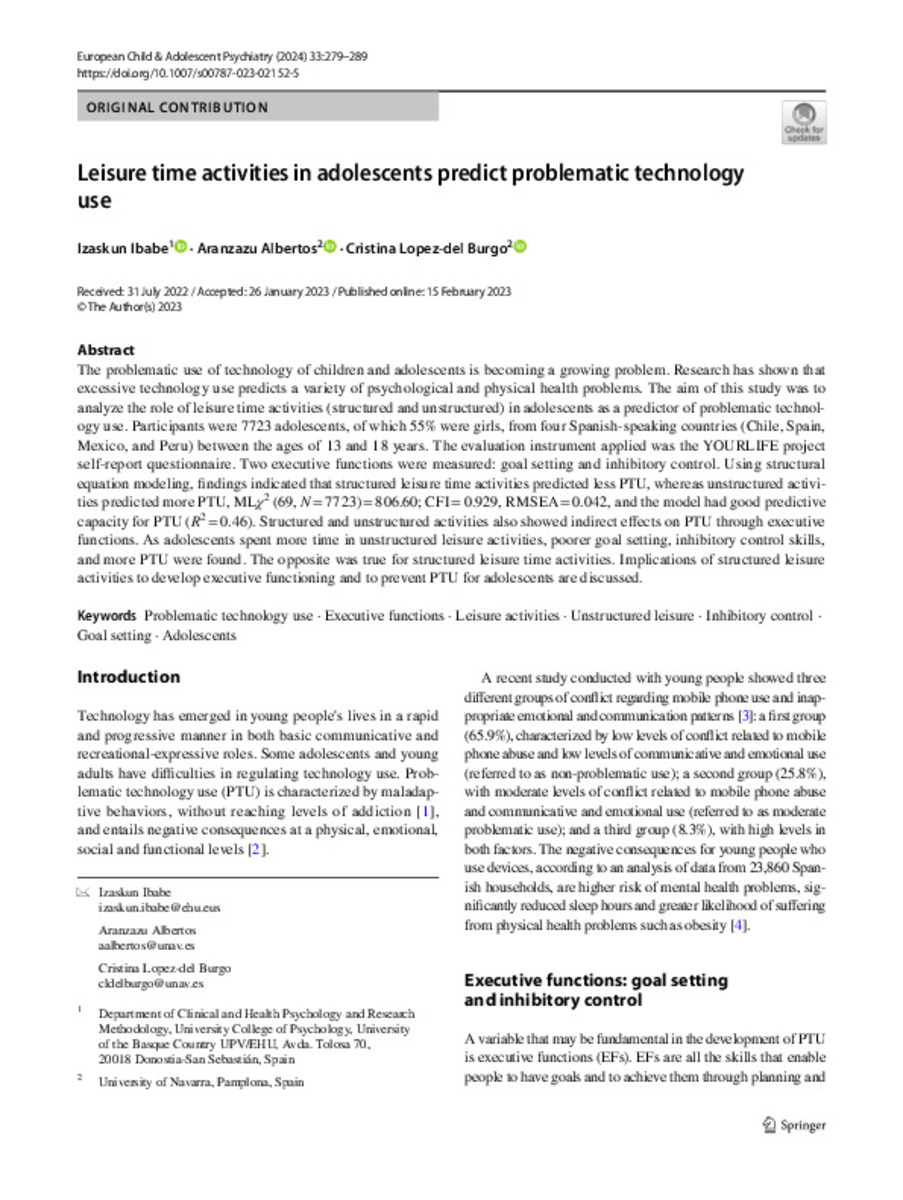Full metadata record
| DC Field | Value | Language |
|---|---|---|
| dc.creator | Ibabe, I. (Izaskun) | - |
| dc.creator | Albertos-San-José, A. (Aránzazu) | - |
| dc.creator | Lopez-del-Burgo, C. (Cristina) | - |
| dc.date.accessioned | 2024-03-26T10:11:17Z | - |
| dc.date.available | 2024-03-26T10:11:17Z | - |
| dc.date.issued | 2023 | - |
| dc.identifier.citation | Ibabe, I. (Izaskun); Albertos-San-José, A. (Aránzazu); Lopez-del-Burgo, C. (Cristina). "Leisure time activities in adolescents predict problematic technology use". European Child & Adolescent Psychiatry. 33, 2023, 279 - 289 | es_ES |
| dc.identifier.issn | 1018-8827 | - |
| dc.identifier.uri | https://hdl.handle.net/10171/69286 | - |
| dc.description.abstract | The problematic use of technology of children and adolescents is becoming a growing problem. Research has shown that excessive technology use predicts a variety of psychological and physical health problems. The aim of this study was to analyze the role of leisure time activities (structured and unstructured) in adolescents as a predictor of problematic technology use. Participants were 7723 adolescents, of which 55% were girls, from four Spanish-speaking countries (Chile, Spain, Mexico, and Peru) between the ages of 13 and 18 years. The evaluation instrument applied was the YOURLIFE project self-report questionnaire. Two executive functions were measured: goal setting and inhibitory control. Using structural equation modeling, findings indicated that structured leisure time activities predicted less PTU, whereas unstructured activities predicted more PTU, MLχ2 (69, N = 7723) = 806.60; CFI = 0.929, RMSEA = 0.042, and the model had good predictive capacity for PTU (R2 = 0.46). Structured and unstructured activities also showed indirect effects on PTU through executive functions. As adolescents spent more time in unstructured leisure activities, poorer goal setting, inhibitory control skills, and more PTU were found. The opposite was true for structured leisure time activities. Implications of structured leisure activities to develop executive functioning and to prevent PTU for adolescents are discussed. | es_ES |
| dc.description.sponsorship | Open Access funding provided thanks to the CRUE-CSIC agreement with Springer Nature. | es_ES |
| dc.language.iso | eng | es_ES |
| dc.publisher | Springer | es_ES |
| dc.rights | info:eu-repo/semantics/openAccess | es_ES |
| dc.subject | Problematic technology use | es_ES |
| dc.subject | Executive functions | es_ES |
| dc.subject | Leisure activities | es_ES |
| dc.subject | Unstructured leisure | es_ES |
| dc.subject | Inhibitory control | es_ES |
| dc.subject | Goal setting | es_ES |
| dc.subject | Adolescents | es_ES |
| dc.title | Leisure time activities in adolescents predict problematic technology use | es_ES |
| dc.type | info:eu-repo/semantics/article | es_ES |
| dc.description.note | This article is licensed under a Creative Commons Attribution 4.0 International License | es_ES |
| dc.identifier.doi | 10.1007/s00787-023-02152-5 | - |
| dadun.citation.endingPage | 289 | es_ES |
| dadun.citation.publicationName | European Child & Adolescent Psychiatry | es_ES |
| dadun.citation.startingPage | 279 | es_ES |
| dadun.citation.volume | 33 | es_ES |
| dc.identifier.pmid | 36790555 | - |
Files in This Item:
Statistics and impact
Items in Dadun are protected by copyright, with all rights reserved, unless otherwise indicated.






